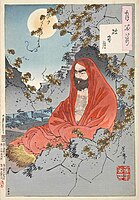User:Ravichandar84/Sandbox/Kanchipuram
Demographics
As of 2001[update] India census, Kanchipuram had a population of 153,140 at a density of 13,428 persons per km2.[1] Males constitute 50.37% of the population and females 49.63%.[2] Kanchipuram has an average literacy rate of 74.8%, higher than the national average of 59.5%: male literacy is 81%, and female literacy is 69%.[1] 10% of the city population is under 6 years of age. According to the 2011 provisional totals b, Kanchipuram had a population of 164,265, constituting 81,987 males and 82,275 females covering an area of 36.14 km2.[1][3]During the British census of 1901, Kanchipuram had a population of 46,164 constituting 44,684 Hindus, 1,313 Muslims, 49 Christians and 118 Jains.[4]
Art and architecture
During the reign of Narasimhavarman I, Kanchipuram had an area of four square miles and an estimated population of 10,000.

Kumarakottam is a temple dedicated to the Hindu god
The mosque near Ekambareswarar temple was built during the rule of Nawab of Arcot in the 17th century. There is another mosque near the Vaikunta Perumal temple that shares a common tank with the Hindu temple. Muslims take part in the festivals of the Varadarajaswamy temple.[21] Christ Church is the oldest church in the city built by a Britisher named Mclean in 1921. The church is built in Scottish style brick structure with arches and pillars.[21]
Society and culture
Kanchipuram is considered to be one of the seven holiest cities for

Kanchipuram is a traditional centre of silk weaving and handloom industries for producing
The
Notes
- ^ a b c Kanchipuram population 2012.
- ^ Kanchipuram : Census 2011.
- ^ Kanchipuram about municipality 2011.
- ^ Imperial Gazetteer of India 1908, pp. 544–546.
- ^ Rao 2008, p. 142.
- ^ a b c d Rao 2008, p. 143.
- ^ a b c d e Ayyar 1991, p. 69.
- ^ Let's Go 2004, p. 584.
- ^ Sajnani 2001, pp. 305.
- ^ a b Ramaswamy 2007, pp. 301–302.
- ^ a b Ayyar 1991, p. 73.
- ^ Ayyar 1991, pp. 70–71.
- ^ a b c Ayyar 1991, p. 86.
- ^ Soundara Rajan 2001, p. 27.
- ^ Rao 2008, p. 110.
- ^ Gateway to Kanchipuram district – Varadaraja Temple 2011.
- ^ K.V. 1975, pp. 26–39.
- ^ a b c d Ayyar 1991, p. 80.
- ^ Ayyar 1991, p. 539.
- ^ Rao 2008, p. 109.
- ^ a b Religious places in Kanchipuram 2011.
- ^ Rao 2008, p. 145.
- ^ Trainor 2001, p. 13.
- ^ a b c d e f Rao 2008, p. 20.
- ^ Zvelebil 1987, p. 125-126.
- ^ McRae 2000, p. 26.
- ^ Smith 1914, p. 468.
- ^ The Hindu & 23 June 2011.
- ^ a b c d e f Rao 2008, pp. 134–135.
- ^ Saraswati 2001, p. 492.
- ^ a b Dalal 2006, p. 186.
- ^ a b Kuttan 2009, pp. 244–245.
- ^ Sharma 1987, pp. 44–46.
